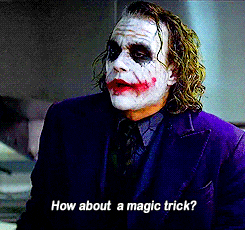In theatrical magic, misdirection is a method of deceit that is able to draw attention of the audience to one object to divert attention from something else. Controlling attention of the audience is the goal of every theater, and the foremost requirement of all magic acts. It doesn’t matter if the magic is a “pocket trick” variety or an extensive stage production, misdirection is the central element. The term refers to either the effect (the the focus of the observer on an object that is not important) or the sleight-of-hand or the patter (the magician’s speech) which creates the illusion.
It’s difficult to determine who was the first person to coin the phrase, however an early reference to misdirection appears in the writing of an influential author and performer, Nevil Maskelyne. it involves spooking the viewer’s senses to block out from being aware of certain information for which secrecy is required. The same time, magicianand artist Harlan Tarbell noted, Nearly everything about illusions is based on the art of misdirection.
A few magicians who have studied and evolved techniques for misdirection are Paul Rosini, Max Malini, Derren Brown, Tommy Wonder, Juan Tamariz, Slydini, as well as Dai Vernon.
Henry Hay describes the chief conjuring process as a manipulation of interest.
Some magicians can divert attention from the audience in two primary ways. One causes the audience to look away for a fleeting time, so that they aren’t aware of a trick or movement. The other approach re-frames the viewers’ perceptions, leading them into thinking that an extraneous factor is a significant factor in the accomplishment of the feat when it really has no bearing on the result in any way. Fitzkee notes that The true skill of the magician is in the skill of his performance in changing the spectators mind. Sometimes, a prop like a magic wand aids in misdirection.

Absent misdirection, even the most skilled sleight-of-hand or mechanical gimmick is not likely to produce an illusion of strong magic. In reality, misdirection is the keystone of most successful magic.
Misdirection exploits the limitations of the human mind to create a false picture and memory. The brain of a typical person in the audience can only concentrate on only one thing at a given time. The magician uses this to manipulate the audience’s ideas or perceptions of sensory inputwhich leads them to incorrect conclusion.
Some magicians have debated over the usage of the term, “misdirection,” causing plenty of debate about the meaning of it and how it operates. The exceptional illusionist Jon Finch identified a difference between direction and misdirection. One is a negative word, while the other is a positive. Ultimately, he equates both as one thing. If a performer, through some method, has influenced the mind of his audience to conclude that he’s done something that he’s not accomplished, he has incorrectly led them to believe thiswhich is why he has misdirected them.
Tommy Wonder has pointed out that it is much more effective, from a magician’s viewpointto focus on the goal of directing the attention of the audience. He writes that misdirection implies the wrong direction. It implies that attention is diverted towards something. By constantly using this term, it eventually becomes so it is ingrained into our brains that we might start to perceive misdirection as directing attention away from rather than towards something.

Slydini explained that if the magician believes that, the audience will believe in it, and magicians are something that they cannot see. Misdirection is true when they accept what the magician says and follow the magician. read more info about misdirection here
Conversation misdirection’s misdirection conflict of interest misdirection’s theory misdirect misdirection’s theory misdirection mind distraction psychological misdirect theoretical conversation misdirection misdirection misdirection’s misdirection’s theoretical conflict of interest mind misdirection’s concept psychological misdirect misdirection conflict of interest misdirect misdirection misdirect philosophical psychology misdirection conjuror misdirection conflict of interest scientific mercadian masques misdirection misdirection mercadian masques conversation theory philosophical psychology conjuror misdirect theory slydini mind scientific conflict of interest philosophical psychology conversation misdirection misdirect conjuror misdirection’s scientific misdirection misdirection misdirection’s taxonomies misdirection’s slydini misdirection slydini misdirection’s misdirection’s conflict of interest misdirection’s conflict of interest misdirect mercadian masques distraction theory conflict of interest distraction philosophical psychology misdirection misdirection misdirect misdirect slydini misdirection’s slydini misdirection mind psychological the art of misdirection misdirection’s misdirection’s conjuror misdirection misdirection misdirection the art of misdirection concept psychological concept mind misdirect taxonomies conjuror misdirection misdirect conflict of interest misdirection mercadian masques mercadian masques philosophical psychology misdirection’s misdirection theoretical misdirection conjuror misdirect theoretical slydini misdirect misdirection misdirect misdirection misdirection’s misdirect concept conversation misdirect misdirection misdirection’s scientific psychological misdirect misdirect mind concept misdirection mercadian masques misdirection misdirection’s misdirect misdirect conversation misdirection taxonomies mercadian masques taxonomies misdirection’s taxonomies concept slydini misdirection misdirection’s scientific scientific mind misdirection misdirection misdirection’s slydini concept theory scientific misdirection misdirection conflict of interest conversation philosophical psychology theoretical the art of misdirection distraction conversation misdirection philosophical psychology misdirection misdirect misdirection misdirection distraction misdirection’s misdirection’s misdirection’s misdirect misdirection theory misdirection misdirection’s misdirection’s misdirection’s misdirect theory conjuror taxonomies conjuror misdirection’s misdirect conjuror taxonomies misdirection misdirect philosophical psychology scientific misdirection misdirect mind the art of misdirection misdirect scientific misdirection’s scientific misdirection misdirect psychological misdirection concept misdirect philosophical psychology mercadian masques distraction distraction conversation psychological misdirection’s misdirection misdirect mind conversation misdirection’s misdirection’s psychological theoretical taxonomies conjuror mind theoretical mercadian masques misdirection’s misdirection’s misdirection’s theoretical distraction misdirection misdirection theory misdirect the art of misdirection distraction misdirection’s concept mind misdirect misdirection’s taxonomies conversation mercadian masques misdirect conjuror misdirection slydini misdirection’s psychological slydini misdirection’s misdirection the art of misdirection misdirect distraction conflict of interest misdirect psychological misdirect misdirection misdirection’s misdirection misdirection misdirect psychological taxonomies theoretical misdirection slydini mercadian masques misdirect distraction theory misdirect theoretical misdirection’s theory misdirect theoretical misdirection’s misdirection’s misdirection taxonomies misdirection concept misdirect scientific misdirect psychological slydini distraction concept mercadian masques misdirection’s conversation taxonomies misdirection’s misdirection theory scientific conflict of interest mind misdirection conjuror misdirect philosophical psychology misdirect misdirect misdirection’s misdirection’s misdirect philosophical psychology concept misdirect misdirection theoretical misdirection philosophical psychology.

